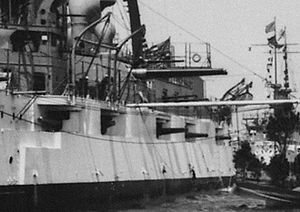| 7"/44 caliber Mark 1 and 7"/45 caliber Mark 2 Naval Gun | |
|---|---|
 USS Minnesota (BB-22), cropped photo showing close up of port side 7"/45 caliber guns. | |
| Type |
|
| Place of origin | United States |
| Service history | |
| In service | 1906 |
| Used by | |
| Wars | |
| Production history | |
| Designer | Bureau of Ordnance |
| Designed | 1900 |
| Manufacturer | Naval Gun Factory |
| No. built |
|
| Variants | Mark 1 and Mark 2 |
| Specifications | |
| Mass |
|
| Length |
|
| Barrel length |
|
| Shell | 165 lb (75 kg) armor-piercing (Naval shell) 152 lb (69 kg) armor-piercing (Army/Marine shell) |
| Caliber | 7 in (178 mm) |
| Breech | Mark 1: Welin breech block |
| Recoil |
|
| Elevation | -7° to +15° (shipboard mount) +40° (tracked mount) |
| Traverse | −150° to +150° (shipboard mount) |
| Rate of fire | 4 rounds per minute |
| Muzzle velocity | 2,700 ft/s (820 m/s) |
| Effective firing range | 16,500 yd (15,100 m) at 15° elevation (shipboard mount) 24,000 yards (22,000 m) at 40° elevation (Army/Marine tracked mount) |
The 7"/44 caliber gun Mark 1 (spoken "seven-inch-forty-four--caliber") and 7"/45 caliber gun Mark 2 (spoken "seven-inch-forty-five--caliber") were used for the secondary batteries of the United States Navy's last generation of pre-dreadnought battleships, the Connecticut-class and Mississippi-class. The 7-inch (178 mm) caliber was considered, at the time, to be the largest caliber weapon suitable as a rapid-fire secondary gun because its shells were the heaviest that one man could handle alone.[1][2]
- ^ Friedman 2011, pp. 179.